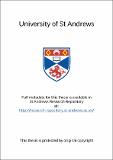Files in this item
Functions of different neurotrophic factors in regulating neuronal survival in the developing peripheral nervous system
Item metadata
| dc.contributor.advisor | Davies, Alun Millward | en |
| dc.contributor.author | Forgie, Alison Jane | en |
| dc.coverage.spatial | 342p | en |
| dc.date.accessioned | 2021-04-08T08:57:09Z | |
| dc.date.available | 2021-04-08T08:57:09Z | |
| dc.date.issued | 2000 | |
| dc.identifier.uri | https://hdl.handle.net/10023/21843 | |
| dc.description.abstract | The main aim of this thesis was to clarify the significance of the GDNF family of neurotrophic factors in neural development. The ability of GDNF, neurturin, persephin and artemin to promote the survival of embryonic chicken parasympathetic, sympathetic and sensory neurons was studied in vitro. All of these neurons responded to GDNF and neurturin, but failed to respond to artemin and persephin. The sensitivity to GDNF and neurturin differed for each type of neuron and varied with age. Competitive RT-PCR revealed correlations between sensitivity to GDNF and neurturin and the level of mRNAs encoding the GPI-linked receptor components for these factors. An attempt was made to generate antibodies against these receptor components so that the relationship between receptor expression and responsiveness could be examined. Although antibodies were successfully generated, they were of limited use due to a lack of specificity. To clarify the ligand specificity of the GPI-linked receptors for members of the GDNF family, the response of neurons from wild-type and GFRal-/- embryos was studied in vitro. Whereas GFRal-deficient nodose neurons failed to respond to GDNF and neurturin, GFRal-deficient submandibular neurons retained normal responsiveness. These results suggest that GFRal mediates GDNF and neurturin signalling in nodose sensory neurons, whereas an alternative receptor mediates the response of submandibular parasympathetic neurons to these factors. Finally, in the course of studying the survival responses of PNS neurons to the GDNF family, compelling evidence for the existence of an NGF-dependent subpopulation of nodose neurons was obtained. In addition to in vitro survival data, RT-PCR demonstrated that TrkA mRNA is expressed at relatively high levels in the developing nodose ganglion and histological analysis of nodose ganglia in NGF-/- mice revealed a significant loss of neurons in the absence of NGF. | en |
| dc.language.iso | en | en |
| dc.publisher | University of St Andrews | en |
| dc.subject.lcc | QP368.7F7 | |
| dc.subject.lcsh | Nerves, Peripheral | en |
| dc.subject.lcsh | Neurons—Growth | en |
| dc.title | Functions of different neurotrophic factors in regulating neuronal survival in the developing peripheral nervous system | en |
| dc.type | Thesis | en |
| dc.type.qualificationlevel | Doctoral | en |
| dc.type.qualificationname | PhD Doctor of Philosopy | en |
| dc.publisher.institution | The University of St Andrews | en |
This item appears in the following Collection(s)
Items in the St Andrews Research Repository are protected by copyright, with all rights reserved, unless otherwise indicated.

